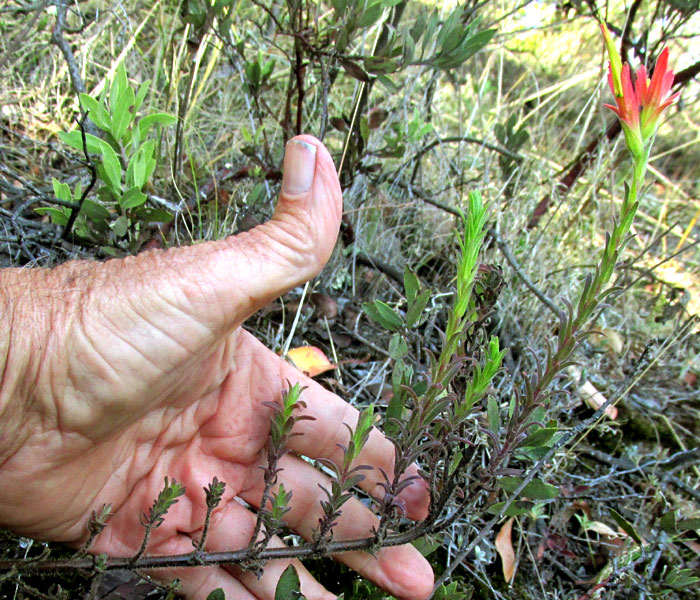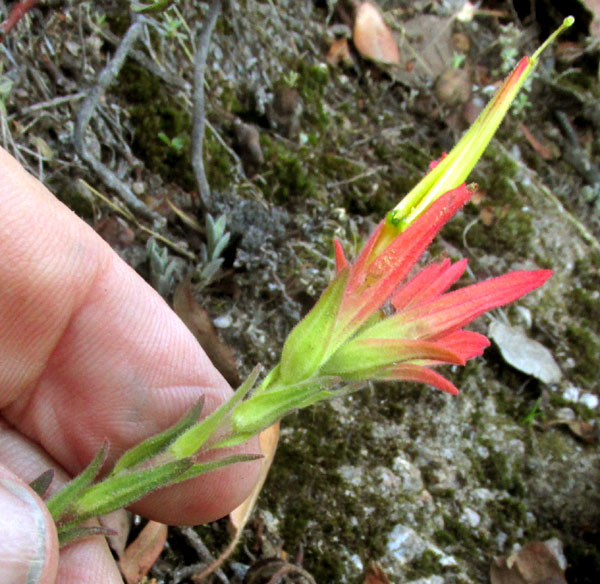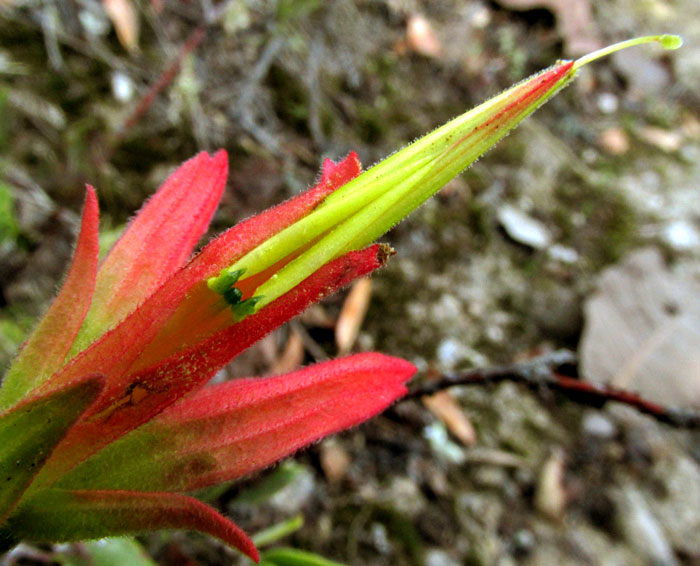Excerpts from Jim Conrad's
Naturalist Newsletter
entry from field notes dated July 1, 2022, on Cerro de la Cruz, at elevation ~2885m (~9465 ft), on the south side of the community of El Pinar, Amealco de Bonfil, Querétaro, MÉXICO, (~N20.17°, ~W100.17°)
SANTA CATALINA PAINTBRUSH

In an open area in the oak woods of a valley opening toward the east, the above wildflower was fairly common, despite the delayed rainy season and the very dry, droughty landscape. Even at this distance anyone familiar with American wildflowers recognizes this as a species of the group normally called Indian paintbrushes in English. That name is applied to many unrelated plants with red flowers grouped at their tips, but the main ones are in the genus Castilleja, like this plant. Castilleja embraces about 200 species in the Americas, northern Eurasia and Pacific Islands. About 119 species occur in the US and Canada, and 40 in Mexico. Maybe three or four occur in our region.

The above picture shows the main field mark for Castilleja Indian paintbrushes. The stems' topmost flower bracts, sepals and corollas tend to be greenish at their bottoms gradually becoming various intensities of red at their tops, with hues of yellow here and there. In this group, the flower parts can be hard to figure out.

Above we see a single mature flower, in the center, accompanied by two immature, unopened flowers, one above and one below. Of the two immature flowers, only the calyxes are visible, both of them red in their upper halves and green below. At the bottom of all the flowers, a leaflike, mostly green bract with red margins and tip arises.
On the mature, open flower at the picture's center, the easiest part to identify is the slender, white style at the picture's top, right corner. It's tipped with a knobby, greenish stigma, where pollen grains are supposed to land and germinate. The slender style extends downward to the top of the ovary, hidden at the flower's bottom. Flowers in the genus Castilleja bear four stamens whose filaments are attached to the corolla's inner walls at two different levels. The picture shows two of the slender, greenish-yellow anthers, which are visible through the single natural split in the corolla tube's wall. The corolla -- narrow, covered with short hairs, yellow-green at the base turning whitish upward, with a splash of red at the tip -- closely wraps around the far side of the upper anthers. The three small, dark green and blackish items at the yellow anthers' bases are corolla teeth, which barely peep over another single split in the red, hairy calyx. Most of the red in the picture, then, is calyx, not corolla.
The above details reveal that our plant is CASTILLEJA TENUIFLORA. The species is distributed from Guatemala north through upland Mexico into Arizona and New Mexico in the US, commonly occurring in upland oak forests and dry scrub. In wildflower books it's often named Santa Catalina Paintbrush.
When I was young, learning the plants, the genus Castilleja was a solid member of the Snapdragon Family, the Scrophulariaceae, but later the genus was switched to the Broomrape Family, the Orobanchaceae. That family is known for most of its members being wholly or partly parasitic on the roots of other species.
Our Castilleja tenuiflora parasitizes the roots of Baccharis conferta, a small tree one of which grew just a few feet from where our pictures were taken. Our plant bears green leaves, however, so it's only half parasitic. It can grow without parasitizing, but not as robustly.
In her 2019 study entitled "Hemiparasitic Interaction between Castilleja tenuiflora (Orobanchaceae) and Baccharis conferta (Asteraceae): Haustorium Anatomy and C- and N-Fluxes," Edith Montes-Hernández and others found that Castilleja tenuiflora takes not only water and minerals from its host, but also carbon and nitrogen, plus they report evidence of the transfer of essential oils.
As described in the 2018 study by Nathan L. Haan and others, entitled "Hemiparasites can transmit indirect effects from their host plants to herbivores," some Castilleja species contain compounds in their leaves that when eaten by certain specialist insect larvae gives those larvae protection against their predators. Thus the Baccharis helps the Castilleja, which helps certain insect species, and who knows how those particular species help other organisms, which in the end leads to a stabilized ecosystem in which the parasitized Baccharis is compensated for its losses to the Castilleja?
Often you see dried portions of our Castilleja tenuiflora offered in traditional Mexican markets as a medicinal herb. One of its several Mexican names is Hierba del Cancer, but mainly it's used for treating cough, dysentery, anxiety, nausea, vomiting and liver and gastrointestinal disorders. In their 2013 study entitled "Anti-Inflammatory Activity of Iridoids and Verbascoside Isolated from Castilleja tenuiflora," Danae Carrillo-Ocampo and others found our plant to contain various known anti-inflammatory compounds, especially a type of monoterpenoid known as iridoids.
When you plop down to rest on a mountain slope and there's a scraggly plant flowering next to you, you just never know what you're getting into, until you start paying attention to the matter.